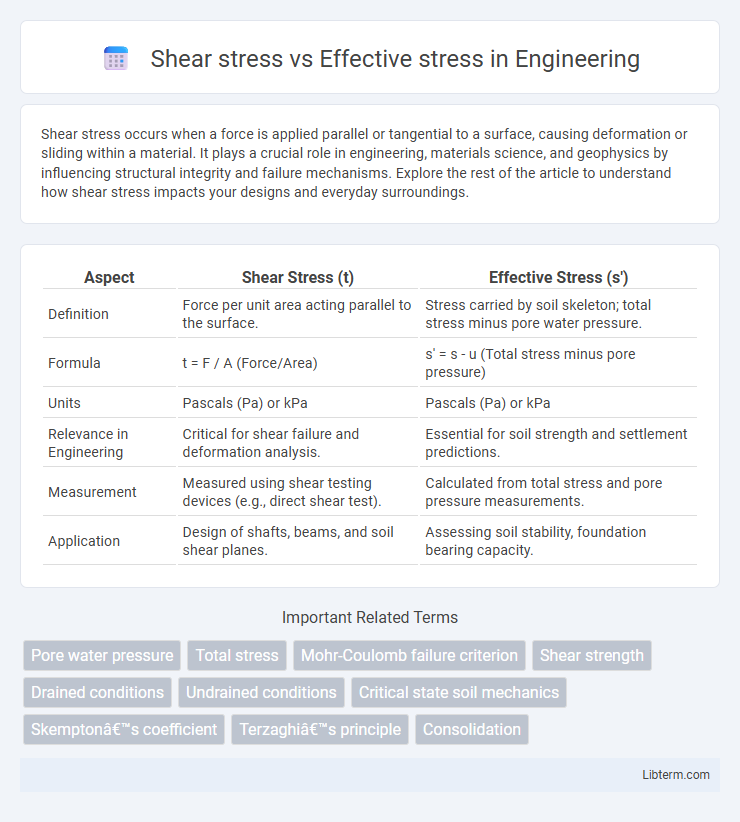Shear stress occurs when a force is applied parallel or tangential to a surface, causing deformation or sliding within a material. It plays a crucial role in engineering, materials science, and geophysics by influencing structural integrity and failure mechanisms. Explore the rest of the article to understand how shear stress impacts your designs and everyday surroundings.
Table of Comparison
| Aspect | Shear Stress (t) | Effective Stress (s') |
|---|---|---|
| Definition | Force per unit area acting parallel to the surface. | Stress carried by soil skeleton; total stress minus pore water pressure. |
| Formula | t = F / A (Force/Area) | s' = s - u (Total stress minus pore pressure) |
| Units | Pascals (Pa) or kPa | Pascals (Pa) or kPa |
| Relevance in Engineering | Critical for shear failure and deformation analysis. | Essential for soil strength and settlement predictions. |
| Measurement | Measured using shear testing devices (e.g., direct shear test). | Calculated from total stress and pore pressure measurements. |
| Application | Design of shafts, beams, and soil shear planes. | Assessing soil stability, foundation bearing capacity. |
Introduction to Shear Stress and Effective Stress
Shear stress represents the internal force per unit area exerted parallel to a material plane, crucial in analyzing soil and rock stability under load conditions. Effective stress, a key concept in soil mechanics, is defined as the difference between total stress and pore water pressure, governing the strength and deformation behavior of saturated soils. Understanding the interplay between shear stress and effective stress enables accurate prediction of soil shear strength and deformation characteristics for geotechnical engineering applications.
Defining Shear Stress in Soil Mechanics
Shear stress in soil mechanics refers to the force per unit area acting parallel to a plane within the soil mass, responsible for causing soil particles to slide past each other. It is a critical parameter influencing soil deformation and failure, typically measured in units of kPa or psi. Understanding shear stress helps engineers predict soil stability and design foundations by evaluating the soil's resistance to shear-induced displacement.
Understanding Effective Stress Concept
Effective stress is a fundamental concept in soil mechanics that represents the stress transmitted through the soil skeleton, excluding pore water pressure. Shear stress acts on soil particles, causing deformation and potential failure, but the soil strength depends primarily on effective stress rather than total stress. Understanding effective stress enables accurate prediction of soil behavior under load by accounting for the influence of pore water pressure on soil strength and stability.
Key Differences Between Shear Stress and Effective Stress
Shear stress refers to the force per unit area acting parallel to a material's surface, influencing deformation and failure along a plane, while effective stress represents the stress carried by the soil skeleton, excluding pore water pressure. Shear stress primarily impacts soil shear strength and slope stability, whereas effective stress governs soil consolidation, settlement, and strength behavior. The differentiation is critical in geotechnical engineering for accurate analysis of soil stability and deformation mechanisms.
Importance in Geotechnical Engineering
Shear stress and effective stress are critical concepts in geotechnical engineering for analyzing soil stability and strength. Effective stress governs the soil's load-bearing capacity by considering pore water pressure, which directly influences shear strength and deformation characteristics. Understanding the relationship between shear stress and effective stress enables accurate prediction of soil behavior under various loading conditions, essential for foundation design and slope stability assessments.
Factors Influencing Shear and Effective Stresses
Shear stress and effective stress are influenced by factors such as soil type, moisture content, and external loading conditions. Shear stress depends on applied forces parallel to the soil surface, while effective stress is governed by the total stress minus pore water pressure within the soil matrix. Permeability and drainage conditions significantly affect pore pressure, which in turn alters effective stress and impacts soil shear strength.
Role in Soil Stability and Slope Failure
Shear stress directly influences the potential for soil movement along failure planes, while effective stress governs soil strength by controlling particle contact forces and pore water pressure. Effective stress stabilizes slopes by increasing frictional resistance between soil grains, whereas elevated shear stress can initiate slope failures when it surpasses soil shear strength. Understanding the balance between shear stress and effective stress is critical for predicting and mitigating slope instability in geotechnical engineering.
Shear Stress vs Effective Stress in Saturated Soils
Shear stress in saturated soils refers to the force per unit area parallel to the soil particle layers, directly influencing soil deformation and failure. Effective stress, defined as the total stress minus pore water pressure, governs the soil's strength and stability by controlling the intergranular contact forces. In saturated soils, variations in pore water pressure significantly impact effective stress, thereby affecting shear strength and potential for soil liquefaction under applied loads.
Real-World Applications and Case Studies
Shear stress and effective stress are critical parameters in geotechnical engineering, directly influencing slope stability and foundation design in civil projects. Effective stress governs soil strength by accounting for pore water pressure, impacting settlement and bearing capacity in real-world cases such as embankment failures and tunnel construction. Numerous case studies demonstrate that accurate assessment of shear stress relative to effective stress ensures safer designs and mitigates risks associated with landslides and soil liquefaction.
Summary: Shear Stress and Effective Stress in Soil Behavior
Shear stress in soil refers to the internal force per unit area resisting deformation caused by applied loads, directly influencing soil strength and stability. Effective stress represents the portion of total stress carried by the soil skeleton, calculated as total stress minus pore water pressure, crucial for predicting soil deformation and shear strength. Understanding the relationship between shear stress and effective stress is essential in geotechnical engineering to assess soil behavior under load and design safe foundations.
Shear stress Infographic

 libterm.com
libterm.com